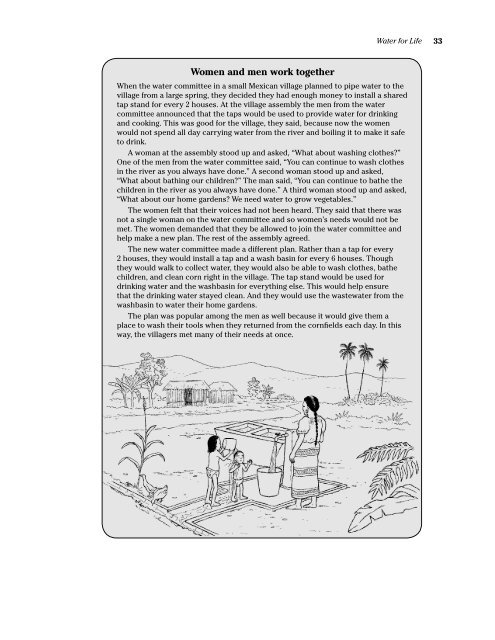Community water security - UN-Water
Community water security - UN-Water
Community water security - UN-Water
Create successful ePaper yourself
Turn your PDF publications into a flip-book with our unique Google optimized e-Paper software.
<strong>Water</strong> for Life<br />
33<br />
Women and men work together<br />
When the <strong>water</strong> committee in a small Mexican village planned to pipe <strong>water</strong> to the<br />
village from a large spring, they decided they had enough money to install a shared<br />
tap stand for every 2 houses. At the village assembly the men from the <strong>water</strong><br />
committee announced that the taps would be used to provide <strong>water</strong> for drinking<br />
and cooking. This was good for the village, they said, because now the women<br />
would not spend all day carrying <strong>water</strong> from the river and boiling it to make it safe<br />
to drink.<br />
A woman at the assembly stood up and asked, “What about washing clothes?”<br />
One of the men from the <strong>water</strong> committee said, “You can continue to wash clothes<br />
in the river as you always have done.” A second woman stood up and asked,<br />
“What about bathing our children?” The man said, “You can continue to bathe the<br />
children in the river as you always have done.” A third woman stood up and asked,<br />
“What about our home gardens? We need <strong>water</strong> to grow vegetables.”<br />
The women felt that their voices had not been heard. They said that there was<br />
not a single woman on the <strong>water</strong> committee and so women’s needs would not be<br />
met. The women demanded that they be allowed to join the <strong>water</strong> committee and<br />
help make a new plan. The rest of the assembly agreed.<br />
The new <strong>water</strong> committee made a different plan. Rather than a tap for every<br />
2 houses, they would install a tap and a wash basin for every 6 houses. Though<br />
they would walk to collect <strong>water</strong>, they would also be able to wash clothes, bathe<br />
children, and clean corn right in the village. The tap stand would be used for<br />
drinking <strong>water</strong> and the washbasin for everything else. This would help ensure<br />
that the drinking <strong>water</strong> stayed clean. And they would use the waste<strong>water</strong> from the<br />
washbasin to <strong>water</strong> their home gardens.<br />
The plan was popular among the men as well because it would give them a<br />
place to wash their tools when they returned from the cornfields each day. In this<br />
way, the villagers met many of their needs at once.
















